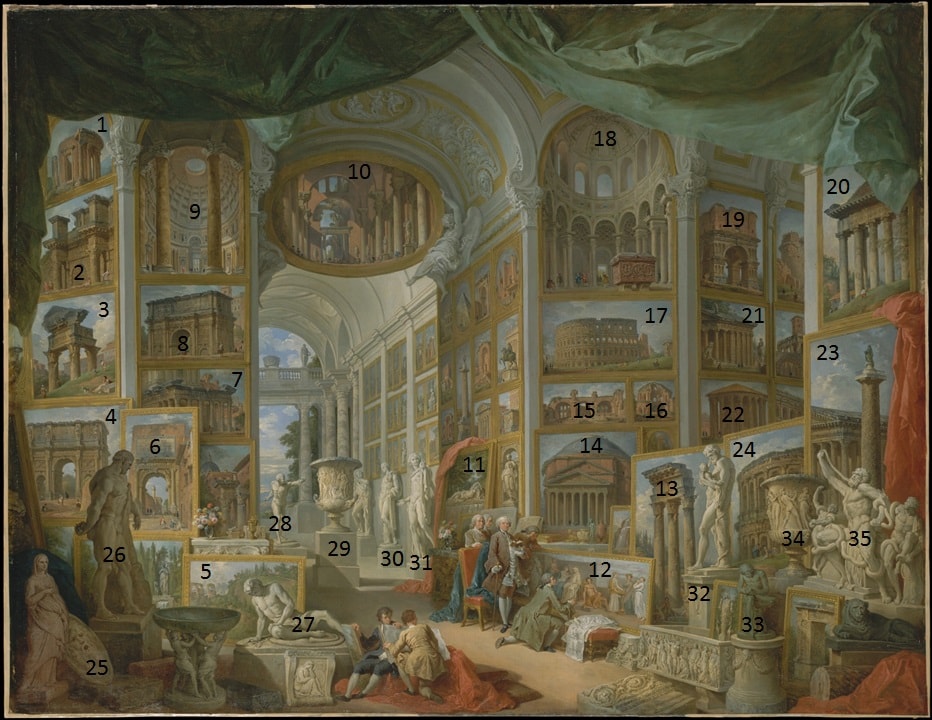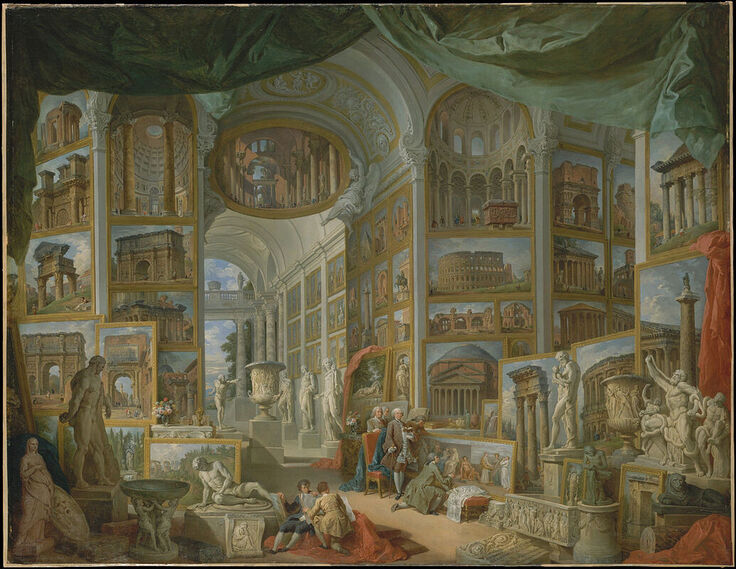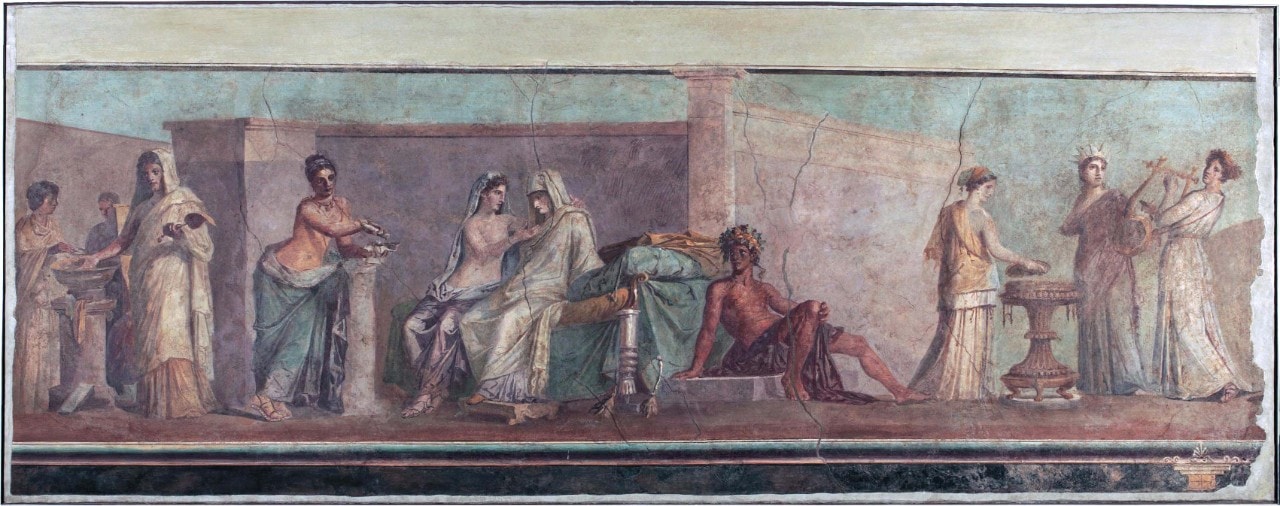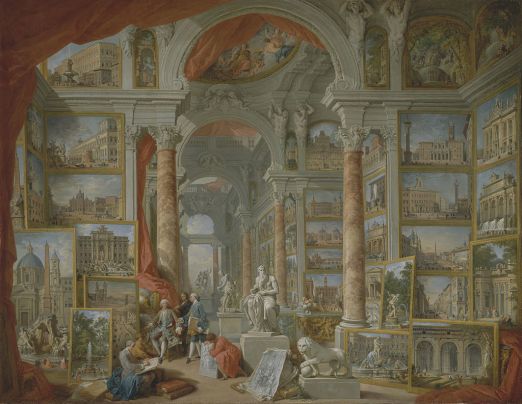 Annotated Ancient Rome Annotated Ancient Rome
Where? Room 629 of the Metropolitan Museum of Art
When? 1757 Commissioned by? Count de Stainville What do you see? On top is a green curtain that is pulled aside to show many paintings and sculptures of ancient Roman monuments. Panini and his patron Count de Stainville appear in the painting. Panini is standing directly behind the chair in the middle, while Count de Stainville is standing in front of him with a book in his hand. In the figure below the paintings are numbered to make it easy to understand what they represent.
Backstory: The painting was created together with a painting of Modern Rome, which is in the same room of the Metropolitan Museum of Art. The idea was that the monuments in this painting represent all the works that a young gentleman of a good family should see on his tour of Rome. This kind of tours was popular among the rich to educate young men about the cultural world.
There are three versions of the Ancient Rome painting and they all look slightly different. Besides the version in the Metropolitan Museum of Art, the Staatsgalerie in Stuttgart has on version, and the Louvre has another version. Why Rome? Rome was the capital of the Roman Empire. It is considered to be the birthplace of the Western civilization. It contains a large number of ruins, monuments, buildings, museums, etc., of significant historical importance. Since the beginning of the Renaissance, it has attracted many well-known artists and contributed to their development. Who is Panini? Giovanni Paolo Panini (1691-1765) was an architect, painter, and professor. He is known as a vedutisti, which is a painter of a veduta (Italian for ‘view’). A veduta is a highly detailed painting of a certain view, such as a city or landscape. While born in Piacenza, he spent most of his life in Rome, which has been the dominant theme in his paintings. Fun fact: Panini painted multiple versions of this painting within three years. The painting is part of a set of three other paintings, a painting of Modern Rome, a painting of Saint Peter’s Square, and a painting of the interior of Saint Peter’s. Because of the popularity of these paintings, he created this set of four paintings twice (remember that there were no photographs possible in his time, so this was probably the best you could get as a picture of Rome). He also created a third and fourth version of Ancient Rome and Modern Rome. Interested in a copy for yourself? Poster or canvas.
Written by Eelco Kappe
References:
0 Comments
Leave a Reply. |
Categories
All
|
- Home
- Blog
-
Museums
- Alte Pinakothek
- Art Institute of Chicago
- Baltimore Museum of Art
- Barber Institute of Fine Arts
- Bargello
- Barnes Foundation
- British Museum
- Church of Sant’Anastasia
- Cleveland Museum of Art
- Courtauld Institute of Art
- Detroit Institute of Arts
- Frans Hals Museum
- Galleria Borghese
- Gallerie dell'Accademia
- Getty Museum
- Guggenheim
- Hermitage Museum
- Kunsthistorisches Museum
- Kunstmuseum Basel
- Legion of Honor Museum
- Louvre
- Mauritshuis
- Metropolitan Museum of Art
- Musee d’Orsay
- Museum of Fine Arts in Boston
- Museum of Modern Art
- National Gallery in London
- National Gallery of Art
- National Museum in Poznań
- Norton Simon Museum
- Ny Carlsberg Glyptotek
- Palace of Versailles
- Palazzo Pitti
- Palazzo Vecchio
- Petit Palais
- Philadelphia Museum of Art
- Prado
- Pushkin Museum
- Ravenna Art Museum
- Rijksmuseum
- San Diego Museum of Art
- Santa Maria delle Grazie
- St. Peter's Basilica
- Städel Museum
- Statens Museum for Kunst
- Tate Britain
- Tate Modern
- Timken Museum of Art
- Uffizi
- Vatican Museums
- Wallace Collection
-
Artists
- Altdorfer
- Anguissola
- Berlin Painter
- Bosch
- Botticelli
- Boucher
- Bronzino
- Bruegel the Elder
- Brunelleschi
- Cabanel
- Caillebotte
- Canova
- Caravaggio
- Carpeaux
- Cezanne
- Cimabue
- David
- Degas
- Delacroix
- De Maria
- Donatello
- El Greco
- Fontana
- Fra Angelico
- Fragonard
- Gauguin
- Gentileschi
- Gericault
- Gonzalez-Torres
- Goya
- Hals
- Hogarth
- Hokusai
- Ingres
- Leonardo da Vinci
- Lippi, Filippo
- Longhi, Barbara
- Lorrain
- Makovsky
- Manet
- Massys
- Matisse
- Merian
- Michelangelo
- Mochi
- Modigliani
- Monet
- Panini
- Parmigianino
- Perugino
- Picasso
- Pisanello
- Raphael
- Rembrandt
- Renoir
- Reynolds
- Rivera
- Rodin
- Rubens
- Scultori
- Seurat
- Steen
- Tintoretto
- Titian
- Toulouse-Lautrec
- Turner
- Uccello
- Van der Weyden
- Van Dyck
- Van Eyck
- Van Gogh
- Van Hemessen
- Vasari
- Velazquez
- Vermeer
- Veronese
- Vigée Le Brun
-
Locations
- Books
- About Us



